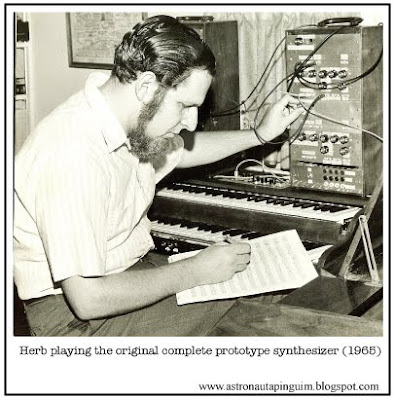
via Fabricio Carvalho on Facebook
Be sure to catch the Astronauta Pinguim interview with Gershon Kingsley.
MATRIXSYNTH Ts
EVERYTHING SYNTH


 "Lawrence Roger Fast was born in Newark, New Jersey (USA) on December 10th, 1951. Since his childhood Larry was very interested in music and electronics. He started to build early electronic circuits about 1966 and his first contact with the Moog modular synthesizers was on 1968. Some of his own designed devices started to be sold on commission on late 1971. Larry attended Lafayette College in Pennsylvania, where he obtained a degree in history in 1973.
"Lawrence Roger Fast was born in Newark, New Jersey (USA) on December 10th, 1951. Since his childhood Larry was very interested in music and electronics. He started to build early electronic circuits about 1966 and his first contact with the Moog modular synthesizers was on 1968. Some of his own designed devices started to be sold on commission on late 1971. Larry attended Lafayette College in Pennsylvania, where he obtained a degree in history in 1973. You'll find the full interview on Astronauta Pinguim.
You'll find the full interview on Astronauta Pinguim. "In 1963 Herb Deutsch met Robert Arthur Moog at a conference of the NYSSMA (New York State School Music Association) in Rochester, NY. The year before, Herb had built a Melodia model theremin, from an article written by Robert Moog on “Electronics World” magazine, in which Bob explained step by step how to assemble the theremin and this was the initial subject of conversation between them.The ideas evolved very quickly, and they decided to work together in a project to build a sound synthesizer, based on the principles of voltage controlled that were already being developed by Bob. In 1964 they designed and assembled the first prototype of the Moog synthesizer and, among other things, it was Herb who insisted on the idea of using a keyboard similar to a piano, because it would be more practical to composers and it would also help to increase the sales of the new instrument."
"In 1963 Herb Deutsch met Robert Arthur Moog at a conference of the NYSSMA (New York State School Music Association) in Rochester, NY. The year before, Herb had built a Melodia model theremin, from an article written by Robert Moog on “Electronics World” magazine, in which Bob explained step by step how to assemble the theremin and this was the initial subject of conversation between them.The ideas evolved very quickly, and they decided to work together in a project to build a sound synthesizer, based on the principles of voltage controlled that were already being developed by Bob. In 1964 they designed and assembled the first prototype of the Moog synthesizer and, among other things, it was Herb who insisted on the idea of using a keyboard similar to a piano, because it would be more practical to composers and it would also help to increase the sales of the new instrument." "David was one of the main [people] responsible for the Mini Moog becoming a very popular instrument in the early seventies, when he decided to travel thru the USA demonstrating and selling the instrument. David Van Koevering was also the developer of the Orchestron, an instrument that was based on Mattel's Optigan, that became very famous when musicians like Patrick Moraz and Kraftwerk members used in their records!"
"David was one of the main [people] responsible for the Mini Moog becoming a very popular instrument in the early seventies, when he decided to travel thru the USA demonstrating and selling the instrument. David Van Koevering was also the developer of the Orchestron, an instrument that was based on Mattel's Optigan, that became very famous when musicians like Patrick Moraz and Kraftwerk members used in their records!" "My EMS relations were mostly with Robin Woob (now the owner) and the technical people, Graham Wood, Graham Hinton, with whom most of the unique modifications to my set-up were designed.
"My EMS relations were mostly with Robin Woob (now the owner) and the technical people, Graham Wood, Graham Hinton, with whom most of the unique modifications to my set-up were designed.












